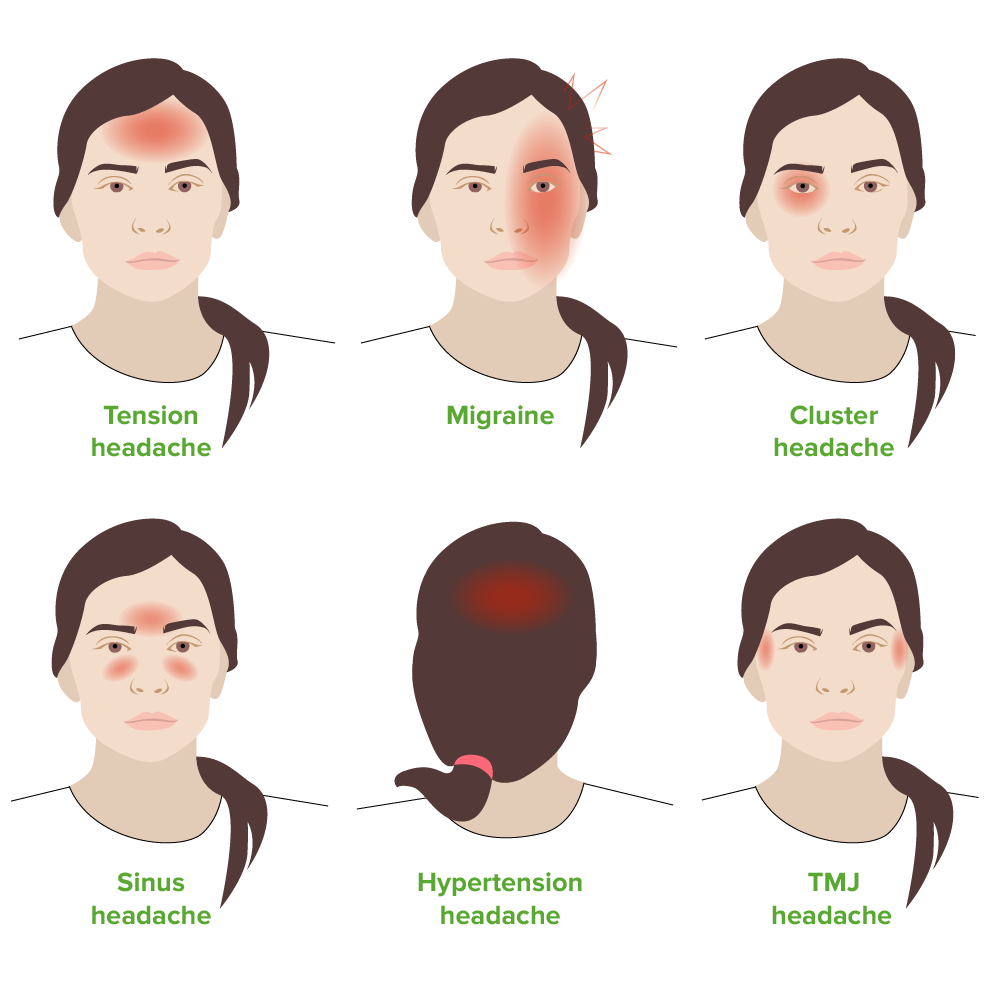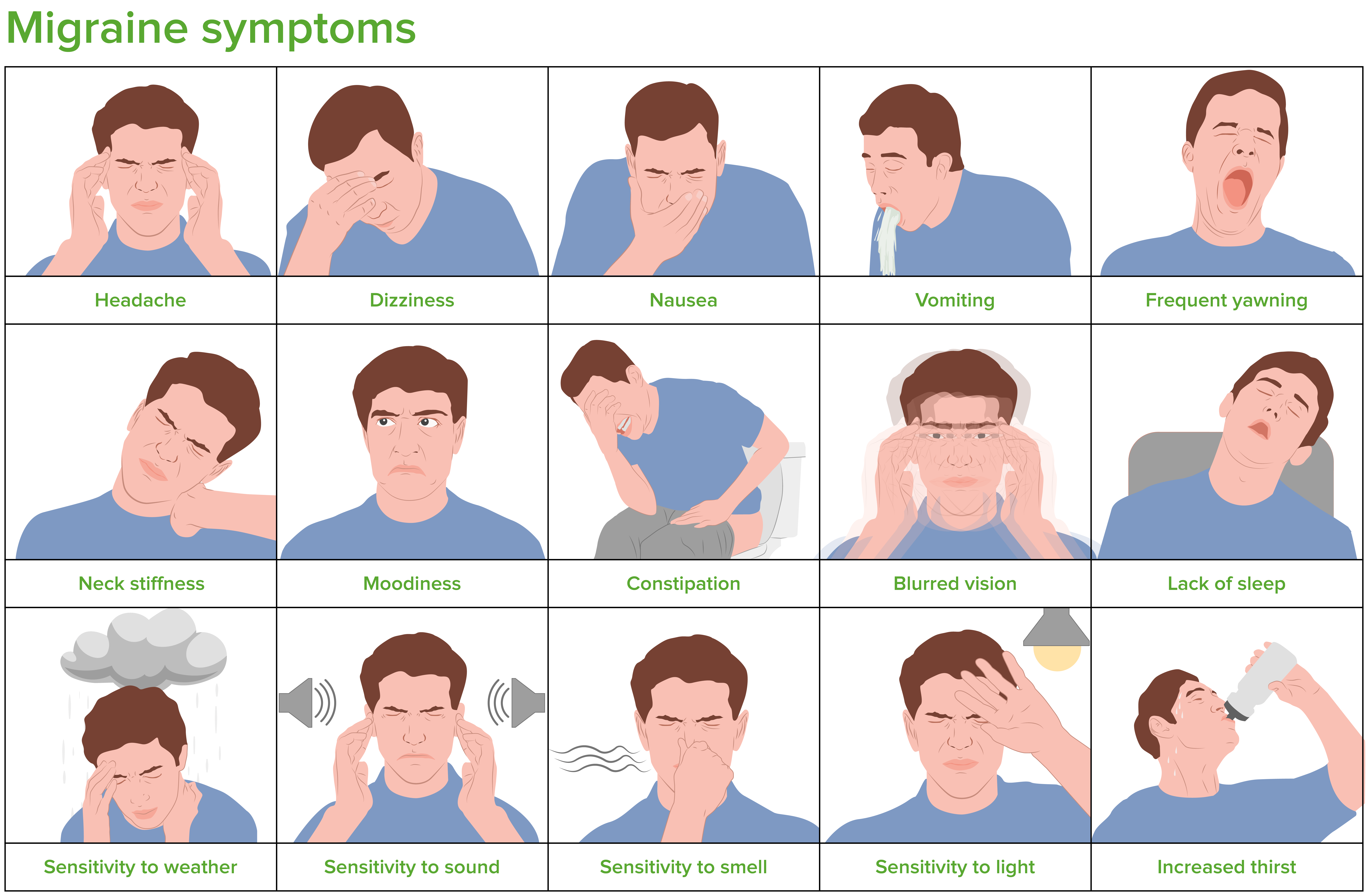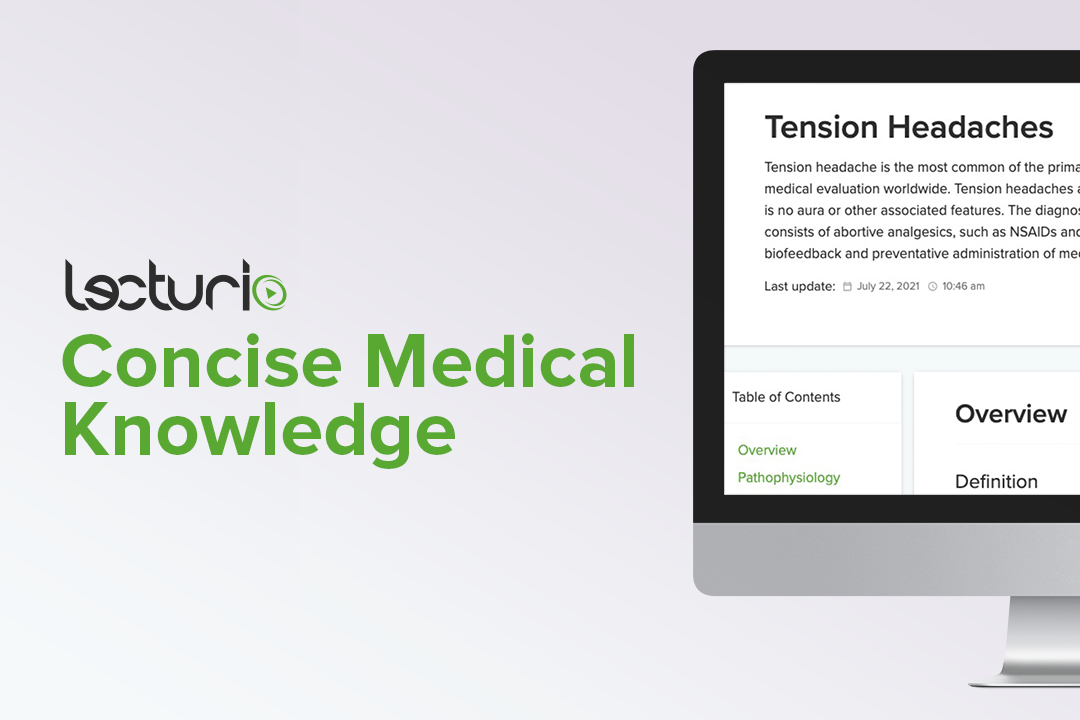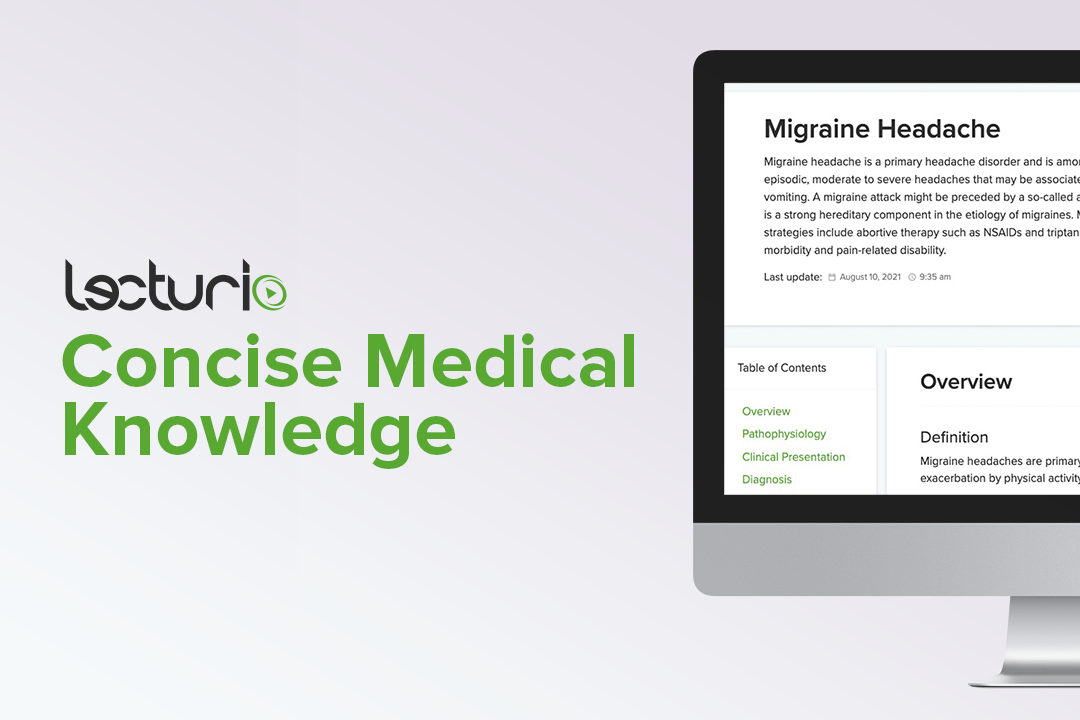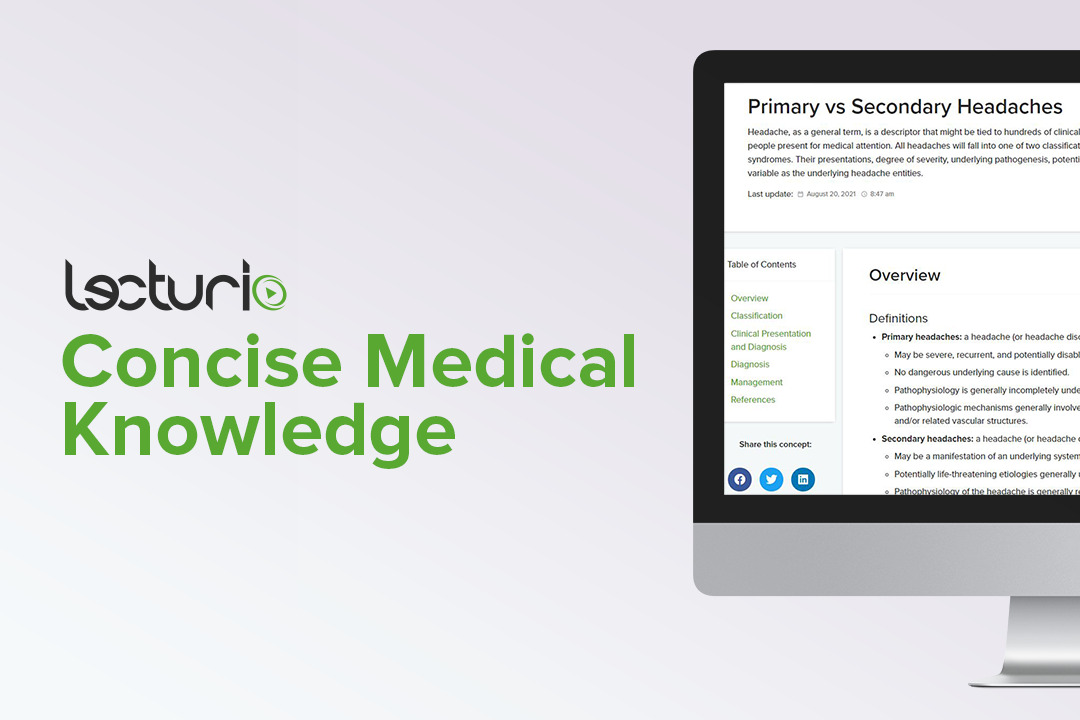Playlist
Show Playlist
Hide Playlist
Headache (Emergency Medicine)
-
Emergency Medicine Bord Approach Headache.pdf
-
Download Lecture Overview
00:01 Hi. 00:02 We're gonna be talking about the approach to headache in the Emergency Department. 00:06 Thinking about patients who present with headache to the Emergency Department, it’s important to think about how often you’re gonna see this. 00:13 So a headache is a really common presenting complaint to the Emergency Department. 00:17 There’s about five million visits estimated per year in the United States and the other thing is that this can be part of constitutional symptoms. 00:26 So if you can think back to the last time that you had a fever or had the flu, you probably had a headache with that and that’s part of a grouping of other symptoms. 00:36 When patients present to the Emergency Department with headaches, we think about dividing headaches into two different groups. 00:43 So the first part is primary headache disorders. 00:46 We’re talking about migraine headaches, cluster headaches, tension headaches. 00:51 And this is the majority of people that will come in with headaches to the ED. 00:55 Secondary headache disorders are due to organic syndromes. 00:58 So that’s due to patients who have subarachnoid hemorrhages, patients who have meningitis. 01:04 That is a large group of patients who present with headaches but primarily here, we’re gonna be talking about these primary headache disorders. 01:11 When patients come to the Emergency Department with headaches, the history that you’re gonna get from the patient is very important. 01:18 And it’s important to try and get all the elements of history from your patient that you’re able to. 01:24 First, we’re gonna talk about the onset of symptoms. 01:27 This is very important, especially when we’re trying to think about whether or not the patient has an organic cause, primarily a subarachnoid hemorrhage. 01:36 Thinking about headache, headache is something that we think about because in the differential of consequence, so when we’re thinking about the most dangerous things that can cause headaches, we’re thinking about the meningitis. 01:47 We’re thinking about patients with the subarachnoid hemorrhage in their brain, and our goal here is to rule out those things. 01:54 Because like I said, the most primary reason that people come to the Emergency Department is for a migraine headache or a cluster headache, and those patients just need symptomatic treatment. 02:03 Our goal here is to try and find a few patients that have that organic cause for headache. 02:08 So thinking about the onset. 02:09 Did the headache start suddenly or was it a gradual onset? So did the headache start over a period of seconds or minutes? Or did it start over a period of hours? Was it a thunderclap headache? What that basically means is the headache started all of a sudden like a thunderclap. 02:25 So it started very, very, very suddenly in nature. 02:29 So all of a sudden they didn’t have a headache, and then one second later, they had a very, very severe headache. 02:35 What were they doing when their headache started? And we’ll talk about some of the common things that point you in the direction of the headache being more related to a serious cause. 02:44 So were they just sitting around or were they exerting themselves? What are the associated symptoms? Are there any neurologic changes? Is the patient having any weakness? Any sensory deficits? Are they having difficulty walking? Are they having difficulty with their speech or their vision? Trying to get that information from the patient is very, very important. 03:06 Are they having a fever? If they have a fever associated with their headache, that may point you in the direction of meningitis or an infection around the brain. 03:15 Are they having any vomiting? Vomiting can be both a concerning symptom but can also be a common thing that patients who have migraine headaches present with. 03:23 So vomiting and migraine headache do sometimes go hand in hand. 03:28 Was there any loss of consciousness? Patients who present with a headache and loss of consciousness definitely can point you in the direction of the subarachnoid hemorrhage. 03:37 Is there any signs of meningitis? Do they have a stiff neck? Are they able to move their neck adequately and was there any trauma? Was there any history of blow to the head, any kind of accident? Prior headache history is also very, very important. 03:51 Does the patient have a history of similar headaches? Is this their worst ever headache? Sometimes, patients can say, “This is the most severe headache I’ve ever had.” It’s very important to think about how you phrase that question to a patient. 04:05 So if you phrase that question to the patient by saying, “Is this your most severe headache you’ve ever had?” They might definitely say, "Yes." But sometimes, it’s helpful to say, “Can you compare this headache to other headaches that you’ve had?” “Is it of similar quality?” “Is it but more severe?” “Is it just lasting longer?” “What are the things that made you come to the Emergency Department for this headache?” Especially in patients who have a known history of headache disorder. 04:31 And then thinking about what they were doing when the headache started. 04:35 Did the headache start with exertion? Did it start when they were having sexual intercourse or a valsalva maneuver? Those three things, so headaches that start with exertion, sexual intercourse, or valsalva, all can point you in the direction again of subarachnoid hemorrhage. 04:50 So by taking these history and getting these historical points, we’re basically trying to help distinguish who has a non-concerning headache or a benign headache, from the patients that have that underlying serious, organic causes of headache. 05:04 Moving on to the physical exam. 05:06 Our job here again is to help distinguish those concerning organic causes of headache from a primary headache process. 05:13 Things that are very important to do on the physical exam are to look at the back of the eye and try and look for papilledema or swelling in the back of the eye. 05:22 Any evidence of papilledema definitely should prompt you to think about a more concerning underlying cause of the headache. 05:28 There’s lots of different things that can cause papilledema but definitely any kind of mass in the brain is one of them, or an elevated intracranial hypertension is another common cause of patients presenting with headache to the Emergency Department. 05:44 A neurologic exam is a very important thing that you wanna make sure you do for your patients. 05:49 You wanna make sure that you check their cranial nerves, that you examine them and make sure that those are all normal. 05:55 You wannna check their restraint as well as their sensation, as well as potentially having your patients stand up and checking their gait and walking them around the room or the Emergency Department to make sure that they have a steady gait. 06:08 Along with that, cerebellum maneuvers can help you determine whether or not your patient has any concerning findings in the cerebellar exam. 06:17 Assessing your patient for meningismus is another important thing to do on the physical exam. 06:22 What that basically means is you wanna have your patient flex their neck. 06:26 Patients who have meningitis will have a lot of difficulty or pain when they’re going to flex their neck. 06:32 There’s other maneuvers that you can do, the Kernig's and Brudzinski maneuvers and those will be discussed in another lecture but those can also indicate inflammation in the meninges. 06:43 So how do we think about the diagnosis here? We wanna basically think about how concerned we are for a secondary headache etiology. 06:51 Primary headaches generally don’t require additional work ups. 06:54 So for example, if a patient comes in and they say they have a migraine headache that feels very similar to their other migraine headaches, you generally don’t need to do additional testing or work up. 07:05 If you’re worried that someone has one of these secondary headache etiologies, those are the patients who you wanna start thinking about additional testing. 07:13 So what do we think about doing when patients have headaches? You wanna think about doing a non-contrast head CT. 07:19 That’s our initial testing that we do for patients who present with headaches. 07:24 And the non-contrast head CT is great at looking for any kind of acute blood in the brain. 07:29 So looking for a subarachnoid hemorrhage. 07:32 As our CAT scan machines get better and better, we’re better able to see subarachnoid blood and then also, whether or not you’re able to see it on a non-contrast head CT will depend on the time frame with which the patient presents to the Emergency Department. 07:47 We know that the non-contrast head CT is most sensitive in the first six hours after the headache began for a subarachnoid hemorrhage. 07:55 We also wanna think about doing a CTA which is a CT angiogram or a CT venogram of the head. 08:03 Those get a better look at the blood vessels, both the arteries as well as the veins that supply blood to the brain and can help give a better idea as to whether or not there’s a bleed or an aneurism present. 08:16 Then you wanna think about doing any labs. 08:17 Labs can sometimes point you in a direction of concern for infection or a possible other underlying reason for altered mental status and for a patient in whom you’re worried about meningitis, they may need a lumbar puncture with analysis of their cerebrospinal fluid and that will be talked more about in another lecture.
About the Lecture
The lecture Headache (Emergency Medicine) by Sharon Bord, MD is from the course Neurologic and Psychiatric Emergencies. It contains the following chapters:
- Approach to Headache
- Approach to Headache: History
- Approach to Headache: Examination
- Approach to Headache: Diagnosis
Included Quiz Questions
Which statement regarding patients presenting with headaches in the emergency department is true?
- A headache can be a constitutional symptom.
- The most common headaches presenting in the emergency department are due to organic disorders.
- Migraine is the only type of headache presenting in the emergency department.
- Secondary headache disorders include cluster and tension headaches.
- Headaches are the most common presenting symptoms seen in the emergency department.
Which of the following can be described as a thunder clap headache?
- Subarachnoid hemorrhage
- Migraine
- Tension
- Cluster
- Space-occupying lesions
Which of the following questions are NOT asked when approaching a case of headache?
- Do you wake up in the middle of the night to urinate?
- Do you have any difficulties talking?
- Is this the worst headache that you have ever had?
- What were you doing when the headaches started?
- Did the headache develop with any kind of exertion?
A patient presented to the emergency department with headache due to probable increased intracranial pressure. Which of the following physical examination findings favor the diagnosis?
- Papilledema
- Neck stiffness
- Decreased visual acuity
- Abdominal swelling
- Right arm weakness
Which of the following situations requires further diagnostic testing?
- A 42-year-old male with acute headache of very high intensity
- A 23-year-old male having a headache associated with severe throbbing pain on one side of the head, accompanied by nausea, vomiting, and extreme sensitivity to light and sound. He says that he has had this type of headache several times before.
- A 26-year-old female with headache for the past 4 days with a history of increased workload and stress since the previous week
- A 24-year-old female with unilateral headache associated with aura and coffee as the precipitating factor
- A 32-year-old male with runny nose and past history of chronic sinusitis
Customer reviews
5,0 of 5 stars
| 5 Stars |
|
5 |
| 4 Stars |
|
0 |
| 3 Stars |
|
0 |
| 2 Stars |
|
0 |
| 1 Star |
|
0 |


